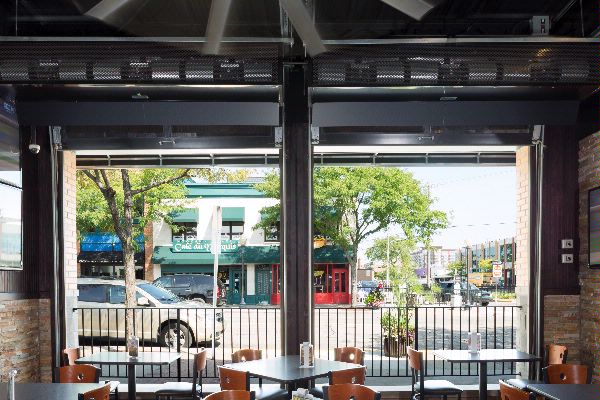 Have you started considering the possibility of installing an air curtain in your place of business? Whether you intend to use one to control the entry of flying insects or as a means of improving climate control efficiency, there are many questions you may want answering before committing. How air curtains work in the first place might be one; getting answers about how installation works might be next. There’s one question, though, that may be more important to you than the others: what do they cost to operate?
Have you started considering the possibility of installing an air curtain in your place of business? Whether you intend to use one to control the entry of flying insects or as a means of improving climate control efficiency, there are many questions you may want answering before committing. How air curtains work in the first place might be one; getting answers about how installation works might be next. There’s one question, though, that may be more important to you than the others: what do they cost to operate?
Running costs is certainly an important question as the answer can help to determine the feasibility of investing in a new installation. The answer, though, is “it depends.” There are several factors to consider when figuring an air curtain’s potential impact on your spending. What are they?
Thinking about an air curtain’s operating costs
The type of air curtain you intend to use is the first factor. An unheated model intended just to keep insects out, for example, will tend to use relatively little power when compared to one which outputs a stream of heated or cooled air to help with climate control. Size plays a role as well; how large of an opening do you have to cover? Wider doors will require curtains which will draw more power to be able to effectively block insects or keep the interior air from rushing outdoors.
The frequency of use is another factor. An air curtain that runs over a loading dock may need to stay on for an extended period, whereas a curtain covering a walk-in freezer door may only turn on a few times a day. These are all things to keep in mind when thinking about how much electricity you may pay for to run air curtains. Generally, though, most applications are not very expensive regarding the power they consume, but there is one other thing to consider.
The potential for saving money with an air curtain
In cases where your installation would have a higher rate of power consumption due to more frequent use or the type of curtain, you will see a reduction in your expenses elsewhere. A key benefit to air curtains is their ability to help maintain indoor temperatures, so you aren’t continually paying to re-cool or heat a space. Though you may incur operating costs for your air curtain, you will see a corresponding reduction in what you pay to run your building’s HVAC system.
In the long run, this can even end up saving you money as you enjoy the increased efficiency of your climate control systems. Therefore, it’s important not to look at air curtains simply from the perspective of what they cost to run. Instead, look at the big picture of their overall impact on your spending. In practically every case, it works out to be the more economical choice. To find out more about how you could work towards saving money or to explore more details about air curtain power consumption, please contact Air Door Distributors at your convenience.


 Have you ever gone to a restaurant in the wintertime and been seated at a table near the door? If so, you probably know what it’s like to have your dining experience interrupted and hampered by drafts of freezing air every time someone opens the door.
Have you ever gone to a restaurant in the wintertime and been seated at a table near the door? If so, you probably know what it’s like to have your dining experience interrupted and hampered by drafts of freezing air every time someone opens the door.


 Air curtains are increasingly a common sight in buildings across the nation. From the front door of a restaurant to the loading dock of a warehouse, air curtains exhibit a versatility that allows them to provide useful climate control maintenance. They do it all with the power of the air flow they produce alone, a flow that’s strong enough to keep flying insects and airborne particles at bay.
Air curtains are increasingly a common sight in buildings across the nation. From the front door of a restaurant to the loading dock of a warehouse, air curtains exhibit a versatility that allows them to provide useful climate control maintenance. They do it all with the power of the air flow they produce alone, a flow that’s strong enough to keep flying insects and airborne particles at bay.
 Few things are as instantly repulsive as the sight of flies buzzing around the inside of a business. That’s why many go to great lengths to ensure these pests do not make it into the building, especially in food service locations where the sight of flies can drive away customers and repel employees. It’s not always as easy as it sounds based on the range of methods flies use to make their way inside. Most commonly, staff entering and exiting the back doors of the restaurant, often to dispose of garbage, create the most significant opportunities for flies to get inside.
Few things are as instantly repulsive as the sight of flies buzzing around the inside of a business. That’s why many go to great lengths to ensure these pests do not make it into the building, especially in food service locations where the sight of flies can drive away customers and repel employees. It’s not always as easy as it sounds based on the range of methods flies use to make their way inside. Most commonly, staff entering and exiting the back doors of the restaurant, often to dispose of garbage, create the most significant opportunities for flies to get inside. What is an air curtain? Merely going by the name alone isn’t necessarily enough to give you a satisfactory answer. After all, how could a curtain be made of air — and how could it have a positive impact on your business, anyway? Answering those questions requires taking a closer look at this exciting technology and how it has found a variety of practical uses across many industries. Take a moment to run through this crash course on the essential facts to understand about
What is an air curtain? Merely going by the name alone isn’t necessarily enough to give you a satisfactory answer. After all, how could a curtain be made of air — and how could it have a positive impact on your business, anyway? Answering those questions requires taking a closer look at this exciting technology and how it has found a variety of practical uses across many industries. Take a moment to run through this crash course on the essential facts to understand about